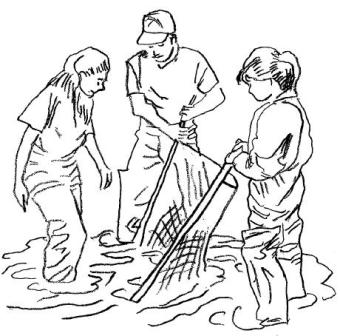 An excellent way to learn about your creek is to study its
benthic macroinvertebrate community. Biologist and other scientist have
collected these organisms from many different places and many different types of creeks. By studying the macroinvertebrate in the
creeks, you can learn something about the chemistry of the water and the physical environment, thereby determining the health of the creek.
An excellent way to learn about your creek is to study its
benthic macroinvertebrate community. Biologist and other scientist have
collected these organisms from many different places and many different types of creeks. By studying the macroinvertebrate in the
creeks, you can learn something about the chemistry of the water and the physical environment, thereby determining the health of the creek.
First things first
If your organization decides to complete independent surveys that include aquatic collections, you must apply for and receive a
Scientific Collection Permit from the WVDNR.
You can reference this example of the WV Save Our Streams
Program's permit to get started. [§20-2-50]
Tools and things you will need
What to do?
- Test the pH of the water with litmus paper, “write it down.”
- Find a area of your creek with a riffle, which is a shallow area with fast-moving water and many rocks of different sizes (mostly cobble 2-10 inches wide).
- Secure the net in the riffle, make sure water is flowing into the net.
- In a small area just above the net (usually about 3 x 3 ft. depending on the net) rub-off the larger rocks with your hands or a small brush, then shuffle your feet back and forth across the area to disturb the rest of the bottom (this is called a kick).
- Remove the net using an upstream scooping motion; place the net on a flat surface on top of a shower curtain or garbage bag (use white or clear).
- Remove the organisms from the net by picking them up with your hands or forceps and place them into trays partially filled with stream water.
- Observe the organisms using containers and magnification and identify the major groups with your ID-guide. Estimate their numbers using a simple rating scale (A) > 50, (C) 5-50, (R) < 5; always identify as many different kinds as you can within certain major groups.
What did you see?
- How many aquatic organisms came off the cobblestones?
- What kinds of aquatic organisms were there?
- What other things were collected in the net?
- What else did you see?
What do you conclude?
- What information can you interpret from the types of aquatic organisms?
- What are your conclusions? "Write down what you think."